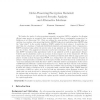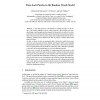CRYPTO
2011
Springer
12 years 4 months ago
2011
Springer
Secure computation enables mutually suspicious parties to compute a joint function of their private inputs while providing strong security guarantees. Amongst other things, even i...
CRYPTO
2011
Springer
12 years 4 months ago
2011
Springer
CRYPTO
2011
Springer
12 years 4 months ago
2011
Springer
Deterministic public-key encryption, introduced by Bellare, Boldyreva, and O’Neill (CRYPTO ’07), provides an alternative to randomized public-key encryption in various scenari...
CRYPTO
2011
Springer
12 years 4 months ago
2011
Springer
Very few public-key cryptosystems are known that can encrypt and decrypt in time b2+o(1) with conjectured security level 2b against conventional computers and quantum computers. Th...
CRYPTO
2011
Springer
12 years 4 months ago
2011
Springer
CRYPTO
2011
Springer
12 years 4 months ago
2011
Springer
We prove that Tandem-DM, one of the two “classical” schemes for turning a blockcipher of 2n-bit key into a double block length hash function, has birthday-type collision resist...
CRYPTO
2011
Springer
12 years 4 months ago
2011
Springer
CRYPTO
2011
Springer
12 years 4 months ago
2011
Springer
Abstract. A time-lock puzzle is a mechanism for sending messages “to the future”. The sender publishes a puzzle whose solution is the message to be sent, thus hiding it until e...


